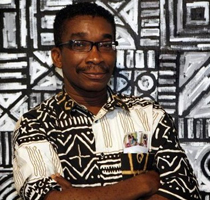If you did miss the exhibition, you do not have to, at least, miss the book. It is, indeed, a collector’s item. The editors of the book, Who Knows Tomorrow, are Udo Kittelman, Chika Okeke-Agulu and Britta Schmitz. It was published by Walter KÖnig,
The artists in the show were all asked to conceive independent contributions for the book relating to their respective artistic interventions in the various Nationalgalerie locations; the book provided them additional opportunity to re-imagine their ideas in a small format, that is, extrapolating their ideas in a minuscule format for the book. In describing the artists’ contributions to the book, Who Knows Tomorrow, Chika Okeke-Agulu writes of El Anatsui:
And finally Anatsui presents photographs from places he visited and events he attended during the two months following his December 2009 site visit to Berlin. This gesture must raise questions as to why an African artist has decided to represent himself and his work with images from places he has been to over a specific period of time. Might this be his coded response to critics who celebrate his residency in Africa, as though it makes him any more African than his compatriots who live and work outside the continent? Clearly, Anatsui wishes to enter the debate about the identity of contemporary African artists like him who are part of the global reality described by Arjun Appadurai: a post colonial world in which subjectivities are mediated by images, travel, nationality, and by networks of finance, technology, and so forth.
Chike Okeke-Agulu, who himself was a former student of Anatsui at the University of Nigeria, Nsukka and is now a Professor of Art History at Princeton University, USA, this time, got it wrong!
I remember sitting in the large audience in the fall of 2008 in the lecture hall at the Metropolitan Museum, New York, and heard Chika Okeke-Agulu make a powerful, thunderous and unforgettable delivery on El Anatsui, as part of the educational lecture series in connection with the twin-exhibition, The Essentials of African Textiles – Design Without End and the Poetics of Cloth: African Textiles/Recent Art, taking place concurrently at the Metropolitan Museum and the Grey Art Gallery, New York, respectively. I mused to myself in the audience: “Chika Okeke-Agulu has a profound understanding of Anatsui’s work. So, whence this new argument about Anatsui’s origin and source of inspiration?”
I was grossly put off by the above clause in Okeke-Agulu’s otherwise beautiful essay and it is this careless commentary by him that has sparked off this essay. I think enough is enough! The curatorship of contemporary African art is fast straying inexorably into dangerous waters and unless the brakes are applied soon, it is going to sink with the whole of the African continent.
Chika Okeke-Agulu, being an artist himself and living in America, would agree with me wholly that Anatsui’s work has more soul than that of his African counterparts plying their trade in the West. The emotive force and power in his work would never attain its present unsurpassable intensity if he were living in Europe or America. That is an indisputable fact. And Okeke-Agulu is fully aware of that. The African artist born and bred in Africa, transplanted from his African locale to the West, goes through a whole series of emotional dislocation, confusion, a struggle to jettison memory, before eventually beginning to find his rhythm in his new environment. And that could take a whole life-time. Some never recover at all from this cultural and emotional dismembering. What was once described as outstanding creative output from the artist often becomes a pale shadow of itself, reduced to sheer, soulless mediocrity, that is, if the artist is lucky to still be creating. Some laid down their art paraphernalia completely never to come back to it again, and took to some other profession to survive. These are realities, which often befall African creative persons who migrate to the West, and Okeke-Agulu knows all this first-hand. I am not the one to be telling him about it.
The plight, misery and degradation of African creative persons in the West was explicitly captured in a recent article Olu Oguibe (Dr.) wrote for the Canadian online journal Maple Tree Literary Supplement, an excerpt of which he earlier posted on his wall on Facebook. It is captioned Esiaba Irobi: The Tragedy of Exile. In this article or, rather, moving tribute and frank, illustrative and anecdotal piece, Oguibe laments the passing of a dear friend and colleague, Esiaba Irobi. He vividly describes the ravaging effect exile had on his departed friend. The person in question was a dramatist – an actor, theater director, playwright and poet. Oguibe thinks that exile dealt his friend a heartless and devastating blow, prematurely truncating his prodigious talent and ability, reducing him to a mere teacher, who for greater part of his sojourn abroad only reproduced (re-interpreted) other people’s work. Oguibe blatantly concludes in this moving and heart-wrenching eulogy that Irobi’s best work was done when he was back home in Nigeria, before fleeing into exile. He writes:
In time scholars will eventually leave their opinion, but I dare say that Esiaba Irobi’s greatest work as a poet and playwright was written during this period, whilst he was in his late twenties, before we went into exile. The classic poems that he is now best remembered for: Judy, Soniya, Frankfurt, Mabera, were all written in Nsukka during this difficult period. So were the great, revolutionary plays that now define his theatre, what I referred to back then as the theatre of the bloody metaphor. Our exile in the West, beginning at the end of the 80’s, saved him from imminent violent confrontation with certain forces in Nigeria, but it also took away from him the very thing that were most crucial to his art; an engaged and engaging community and an appreciative audience. He struggled in Britain to find a place, to get his work out, to locate a space in which to continue to flourish, and when that failed, he relocated to America, yet fate dealt him no easier hand. Exile destroyed his promise, and eventually took his life.
From the foregoing, migration or exile to the West is not necessarily the best proposition or panacea for the African artist who wants to move to the ‘center’ for recognition and a more salubrious environment to create. Many an African artist/writer, like Olu Oguibe’s good friend, Irobi, has miserably fallen by the roadside, squandering their talents away, what with their work constantly meeting with utter rejection and scorn. Even the most resilient spirit will but buckle under the burden of this cruel isolation and rejection. Needless to say, the attrition rate for African artists who migrate to the West is, in fact, disproportionately far higher than African artists in Africa who abandon their art along the way.
I, hereby, venture to say, without any fear of contradiction, that Anatsui presenting photographs of places he visited and events he attended during his site visit to Berlin is “no coded response”, I reiterate, “no coded response”, to critics who celebrate his residency in Africa.





No Comments so far ↓
There are no comments yet...Kick things off by filling out the form below.